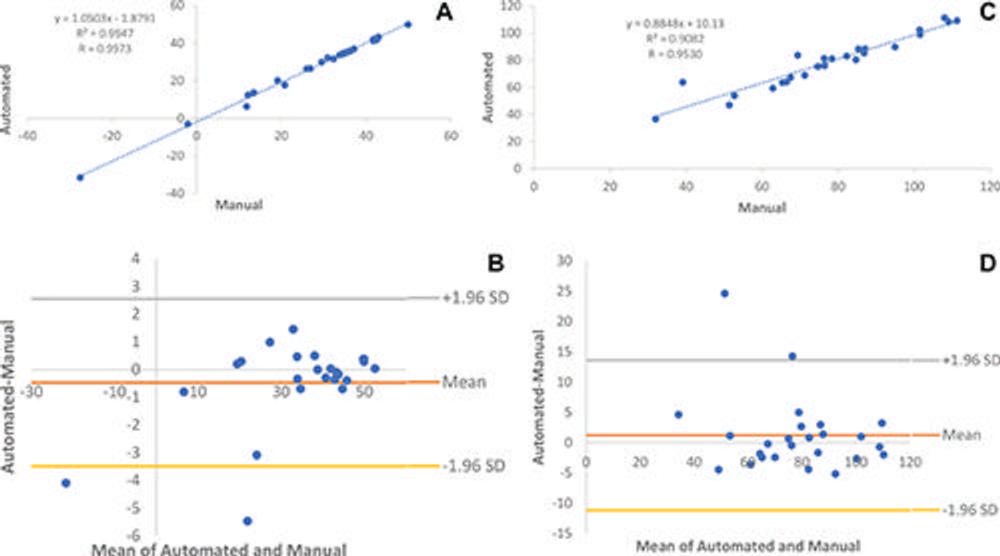Artificial Intelligence May Improve Diabetes Diagnosis
Released: April 05, 2022
At A Glance
- Using a deep learning model, researchers were able to identify early signs of type 2 diabetes on abdominal CT scans.
- The results showed that patients with diabetes had lower pancreas density and higher visceral fat amounts than patients without diabetes.
- Earlier diagnosis will allow patients to make lifestyle changes to alter the progression of the disease.
- RSNA Media Relations
1-630-590-7762
media@rsna.org - Linda Brooks
1-630-590-7738
lbrooks@rsna.org - Imani Harris
1-630-481-1009
iharris@rsna.org
OAK BROOK, Ill. — Using a fully-automated artificial intelligence (AI) deep learning model, researchers were able to identify early signs of type 2 diabetes on abdominal CT scans, according to a new study published in the journal Radiology.
Type 2 diabetes affects approximately 13% of all U.S. adults and an additional 34.5% of adults meet the criteria for prediabetes. Due to the slow onset of symptoms, it is important to diagnose the disease in its early stages. Some cases of pre-diabetes can last up to 8 years and an earlier diagnosis will allow patients to make lifestyle changes to alter the progression of the disease.
Abdominal CT imaging can be a promising tool to diagnose type 2 diabetes. CT imaging is already widely used in clinical practices, and it can provide a significant amount of information about the pancreas. Previous studies have shown that patients with diabetes tend to accumulate more visceral fat and fat within the pancreas than non-diabetic patients. However, not much work has been done to study the liver, muscles and blood vessels around the pancreas, said study co-senior author Ronald M. Summers, M.D., Ph.D., senior investigator and staff radiologist at the National Institutes of Health Clinical Center in Bethesda, Maryland.
"The analysis of both pancreatic and extra-pancreatic features is a novel approach and has not been shown in previous work to our knowledge," said first author Hima Tallam, B.S.E., M.D./Ph.D. student.
The manual analysis of low-dose non-contrast pancreatic CT images by a radiologist or trained specialist is a time-intensive and difficult process. To address these clinical challenges, there is a need for the improvement of automated image analysis of the pancreas, the authors said.
For this retrospective study, Dr. Summers and colleagues, in close collaboration with co-senior author Perry J. Pickhardt, M.D., professor of radiology at the University of Wisconsin School of Medicine & Public Health, used a dataset of patients who had undergone routine colorectal cancer screening with CT at the University of Wisconsin Hospital and Clinics. Of the 8,992 patients who had been screened between 2004 and 2016, 572 had been diagnosed with type 2 diabetes and 1,880 with dysglycemia, a term that refers to blood sugar levels that go too low or too high. There was no overlap between diabetes and dysglycemic diagnosis.
To build the deep learning model, the researchers used a total of 471 images obtained from a variety of datasets, including the Medical Data Decathlon, The Cancer Imaging Archive and the Beyond Cranial Vault challenge. The 471 images were then divided into three subsets: 424 for training, 8 for validation and 39 for test sets. Researchers also included data from four rounds of active learning.
The deep learning model displayed excellent results, demonstrating virtually no difference compared to manual analysis. In addition to the various pancreatic features, the model also analyzed the visceral fat, density and volumes of the surrounding abdominal muscles and organs.
The results showed that patients with diabetes had lower pancreas density and higher visceral fat amounts than patients without diabetes.
"We found that diabetes was associated with the amount of fat within the pancreas and inside the patients' abdomens," Dr. Summers said. "The more fat in those two locations, the more likely the patients were to have diabetes for a longer period of time."
The best predictors of type 2 diabetes in the final model included intrapancreatic fat percentage, pancreas fractal dimension, plaque severity between the L1-L4 vertebra level, average liver CT attenuation, and BMI. The deep learning model used these predictors to accurately discern patients with and without diabetes.
"This study is a step towards the wider use of automated methods to address clinical challenges," the authors said. "It may also inform future work investigating the reason for pancreatic changes that occur in patients with diabetes."
"Fully Automated Abdominal CT Biomarkers for Type 2 Diabetes Using Deep Learning." Collaborating with Tallam and Drs. Summers and Pickhardt were Daniel C. Elton, Ph.D., Sungwon Lee, M.D., Ph.D., and Paul Wakim, Ph.D.
Radiology is edited by David A. Bluemke, M.D., Ph.D., University of Wisconsin School of Medicine and Public Health, Madison, Wisconsin, and owned and published by the Radiological Society of North America, Inc. (https://pubs.rsna.org/journal/radiology)
RSNA is an association of radiologists, radiation oncologists, medical physicists and related scientists promoting excellence in patient care and health care delivery through education, research and technologic innovation. The Society is based in Oak Brook, Illinois. (RSNA.org)
For patient-friendly information on abdominal CT, visit RadiologyInfo.org.

Figure 1. Standards for Reporting Diagnostic Accuracy flowcharts. (A) Chart shows patient flow in deep learning model development. Institution 1 is the University of Wisconsin Hospital & Clinics, and institution 2 is the National Naval Medical Center. (B) Chart shows patient flow in clinical study. CTC = CT colonography, DICOM = Digital Imaging and Communications in Medicine.
High-res (TIF) version
(Right-click and Save As)

Figure 2. Pancreas segmentations in patients from each of the five visceral fat groups. Segmentation performance is better for patients with higher visceral fat (group 5 being the highest). Visceral fat percentages at the L1 level for the specific patients shown here were 9.81% in group 1, 13.72% in group 2, 20.19% in group 3, 27.88% in group 4, and 32.42% in group 5; Dice similarity coefficients were 0.36, 0.62, 0.78, 0.81, and 0.86, respectively. In the automated segmentation images, the green area indicates full segmentation and the yellow area indicates segmentation after erosion. Obs. = observer.
High-res (TIF) version
(Right-click and Save As)

Figure 3. Automated and manual measurements for 25 randomly selected patients who underwent supine CT colonography. (A, B) Comparison of average CT attenuation in Hounsfield units with (A) linear regression and (B) Bland-Altman plots (r2 = 0.99, P < .001; Bland-Altman 95% limits of agreement: 23.49 to 2.55 HU). (C, D) Comparison of pancreas volume in milliliters with (C) linear regression and (D) Bland-Altman plots (r2 = 0.91, P < .001; Bland-Altman 95% limits of agreement: 211.18 to 13.60 mL).
High-res (TIF) version
(Right-click and Save As)

Figure 4. (A, B) Bar graphs show average Hounsfield units of pancreas in patients with (A) type 2 diabetes mellitus and (B) dysglycemia compared with participants without diabetes. (C, D) Bar graphs show average Hounsfield units of pancreas after controlling for body mass index in patients with (C) type 2 diabetes and (D) dysglycemia compared with participants without diabetes. Error bars show 95% CIs. Numbers in parentheses are the times between diagnosis (Dx) and imaging.
High-res (TIF) version
(Right-click and Save As)

Figure 5. Examples of pancreas segmentations on unenhanced axial abdominal CT images in healthy participants and patients with type 2 diabetes mellitus. Images on left are original CT images, and images on right show segmentations overlaid on the original CT images. (A) Images in a nondiabetic 61-year-old man with average pancreas CT attenuation of 35.50 HU ± 47.96 and pancreatic volume of 97.6 mL. (B) Images in a 59-year-old man with type 2 diabetes who was diagnosed 144 days before CT. Average pancreas CT attenuation was 20.66 HU ± 81.99 and pancreatic volume was 77.10 mL. (C) Images in a 67-year-old man with type 2 diabetes who was diagnosed 595 days after CT. Average pancreas CT attenuation was 18.46 HU ± 48.30 and pancreatic volume was 72.88 mL. The green area indicates full segmentation and the yellow area indicates segmentation after erosion.
High-res (TIF) version
(Right-click and Save As)

